How to Make Money from YouTube Videos (A Complete Guide)

With increasing bandwidth and access to devices, video content consumption on the internet is on the rise. Even TV channels and media companies are uploading video content to YouTube and earning revenue from advertising.

Click Here to Get a Free Digital Marketing Course
Now anyone can create video content and distribute it online for the whole world to see. No need of huge investments or approvals from government organizations! The good thing about technology is that it breaks the barriers of entry for individuals like us.
Now you and me have a chance to compete with the big boys and all that is required of us is create something of value. In this case, good quality video content. We can also earn revenue on par with what the big boys. The playing field has been levelled.
The opportunities and possibilities with online videos are so vast that many people still find it hard to believe that – can this be this easy? This post is going to answer that question.
One of my friends makes $20,000 a month from YouTube videos. He has worked hard and it took him 5-6 years to reach this level. I know a few more people who easily make $3,000 – $5,000 a month from YouTube. They are individuals, not companies. That’s life changing income.
My goals are a bit more modest for now. I expect to make $1,000 a month from YouTube videos by the end of 2016. That’s a significant revenue stream for any individual or business. Once I reach that goal, I can reinvest the income and grow even faster.
Join me on my journey to cracking video marketing with YouTube. And as I learn and implement things to reach this goal, I will share everything on this blog.
Note: In this context we are only talking about monetization via AdSense ads / YouTube partner program. If you consider YouTube as a marketing channel, you can drive traffic back to your website from your YouTube videos and make it an entry point for your sales funnel.
YouTube video marketing is going to be a long topic and this article is the first part of many articles.
In the future articles we will explore:
- How to choose topics for video creation – keyword and topic research
- How to create videos on a budget without a camera
- How to enable monetization for your videos
- How to drive consistent traffic to your videos at no cost
- How to optimize your YouTube videos for SEO and Virality
Calculating ROI from Videos
I believe that the best way to calculate the return on investment from your videos is to come up with an estimate of ad revenue / earnings per 1,000 views.
Earnings per 1,000 views of a YouTube video is a rough way to calculate earnings because there are so many other factors involved in the earning potential of each video. Yet, it is a simple and easy metric to measure the performance of your videos and estimate ROI.
It costs time and money to create videos and without a metric like this, it is difficult to stay motivated to create the videos in the first place. Right?
Once we know the estimated ROI, the next steps become very simple. Choose a topic, create a video, drive views, earn. Repeat the process and create more videos. So in this article we will be mostly focusing on estimating the ROI from YouTube videos.
What are the Earnings Per 1,000 Views?
The answer is not straight forward and it varies based on the niche, the demographics and the engagement on your videos. In certain markets, you will earn more per 1,000 views. In other markets and demographics, the revenue is quite less.
As a general rule for every 1,000 views you will earn around $1 to $3. In the future, this number is bound to go up.
The revenue per 1,000 views also varies with the time of the year. Towards the end of the year where countries all around the world celebrate Diwali, Christmas and New Year, the sales are high and the ad dollars flowing from the companies are also high. So obviously you are going to make relatively more income from your videos in peak seasons.
Earnings by Demographic
I have a small channel with 15-20 videos on a specific topic. This channel is 5 years old and I had made these videos to drive traffic to a website and promote a product as an affiliate. That program died long back.
For a long time these videos were just getting views without any returns! Now I am using this channel to experiment with with the YouTube partnership program. It has been a few weeks since I enabled monetization for these videos.
In following screenshot you can see that I am earning around $3.3 per 1,000 views for the traffic coming from US. This is just one of the YouTube channels that I own.
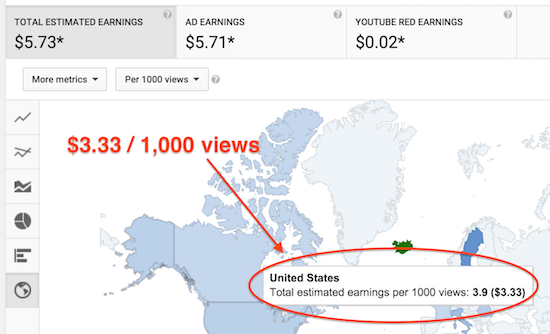
Advertisers pay significantly higher costs to reach customers in countries like US and UK. Hence the higher earnings from such traffic.
However for traffic from India and other such countries, the earnings are 1/3rd or less than that of US. I believe this figure will increase gradually in the next 3-5 years.
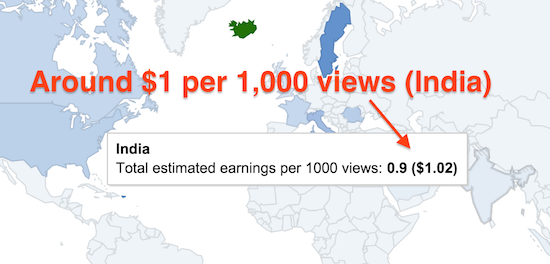
Your earnings will also depend on the kind of engagement that your video creates with the audience.
If you upload low quality videos, the average duration of views will be less and your revenue will be less than expected. But assuming that you create good and useful videos, you will earn good revenue.
The videos in this channel gets majority of the views from US and India. UK and Philippines comes next.
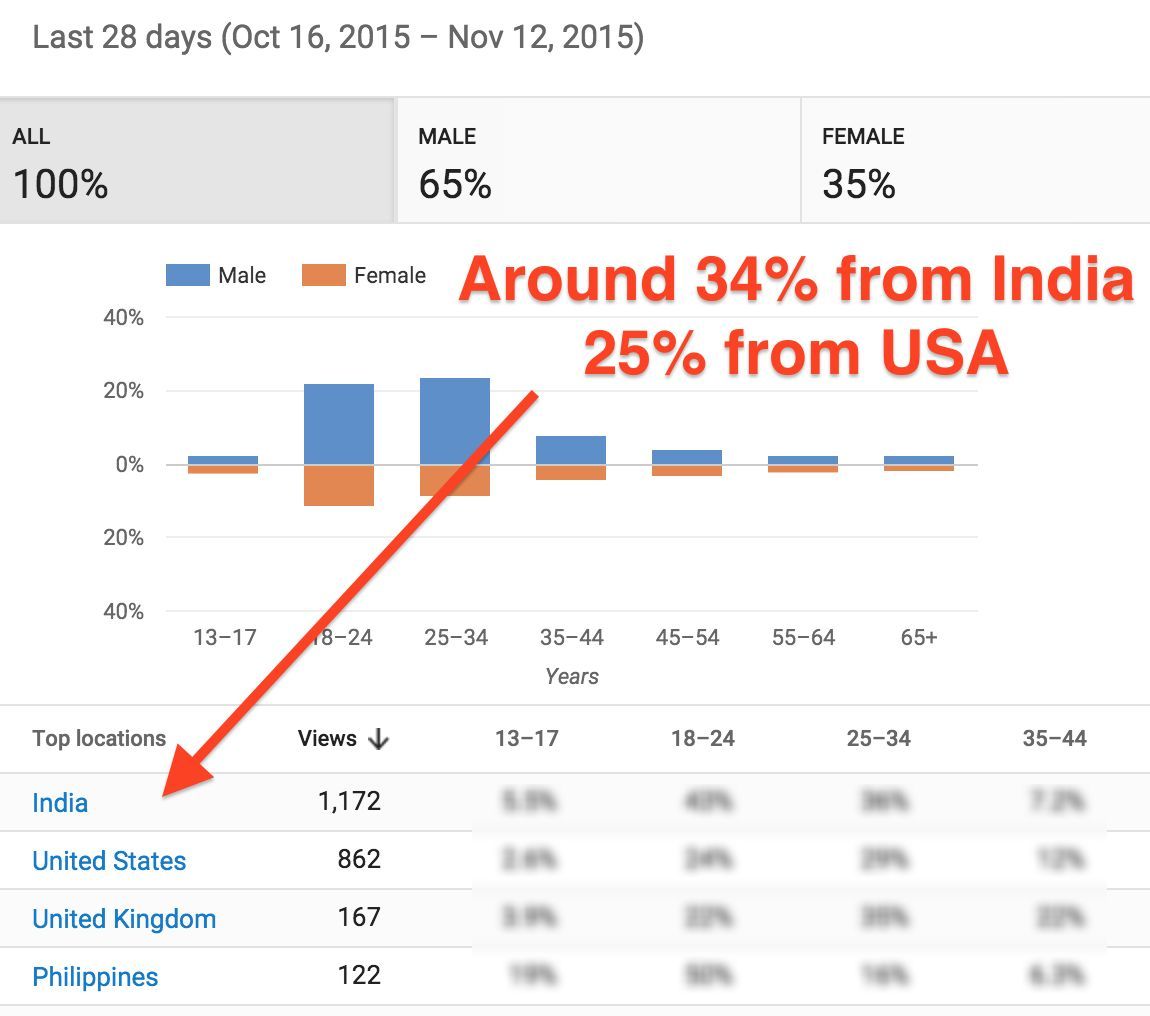
There is a significant chunk of views coming from many countries which is not displayed in the screenshot above.
The analytics of all the videos on this channel shows me the following figures:

You can see that in the last 28 days (Oct 16th to Nov 12th) I made $5.84 from 3.4K views which is an average of $1.7/1,000 views. With a different demographic and interest group, this number can be vastly different.
I own some YouTube channels where the topics are more inclined towards Indian audience, I earn just around $1 per 1,000 views in those channels.
Now that you have a fair idea about the revenue potential of YouTube videos, let’s have a quick look at how to drive traffic to your videos. (In the future articles, we will explore traffic generation in-depth).
Driving Views to Your Videos
Content on YouTube seems to have a better shelf life than written content on our own website. Videos are not easy to make and hence they have higher value because of scarcity.
YouTube videos have more than one source of traffic. Unlike website articles, the videos get ranked on videos section of Google search, shows up as related videos along side other videos and sometimes people embed these videos on their own blogs and websites.
Have a look at one of the videos I made in 2010. I have not promoted it much except for a few social shares on the first week of its upload. Since the content is good, it is getting likes and comments.
This allows YouTube to learn that the video is of good value and it gets promoted via related videos. It also ranks well in Google and inside YouTube search.
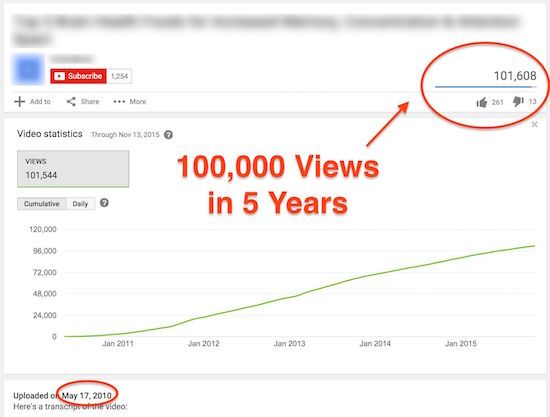
The video that you see above has got 100,000+ views. If I had enabled monetization long back, I would have made around $200 from this video alone.
The views to these videos mostly comes from YouTube internal search. The next one is External which is defined as “Traffic from websites and apps that embed your videos or link to your videos on YouTube.”

External also includes the YouTube video links that you see on Google’s search results pages. That could be a major source of traffic if you manage to rank a video well in Google search (than YouTube internal search).
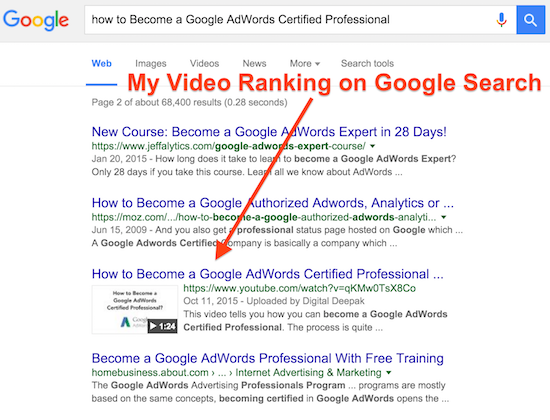
The point to take home is this: if you create a good video, driving views to it is much easier than a similar article on a web page. And the consistency of traffic over the years is much higher than other platforms.
There are many more methods to drive traffic to your YouTube videos. That’s a topic for another article.
Setting Income Goals with YouTube
How can we make $1,000 a month from YouTube? If you have just one video and if that video gets a 1,000,000 views a month, you will make at least $1,000 a month (Considering that we are earning only $1 per 1,000 views).
But obviously getting a million views a month is difficult (not impossible). So what if you make 100 videos? 10,000 views a month per video will take you to your goal.
Or you can upload 1,000 videos and expect to get 1,000 views per video per month. That can take you to $1,000 a month.
If you can make 3 videos a day, in 1 year you will own 1,000 videos. And yes, that’s possible. I am not talking about videos that need a camera and a face. Look at this video I made about Google Adwords Certification. It is a one-minute “infomovie” that is useful to the audience. It took me 2 hours to create that video.
I can make 3 videos like that per day (if I didn’t have any other work). But I can always employ someone to make videos for me. If I reach $300 a month in income, I can hire someone to help me with video creation and from that point, things will go exponentially. Yes, things look great on paper, but it is difficult to implement. But without a plan we can do nothing anyway.
Enabling Monetization
To start earning revenue with your videos, you have to enable monetization for your videos. You should also open an AdSense account (explained below).
Inside your YouTube channel, select Monetization.
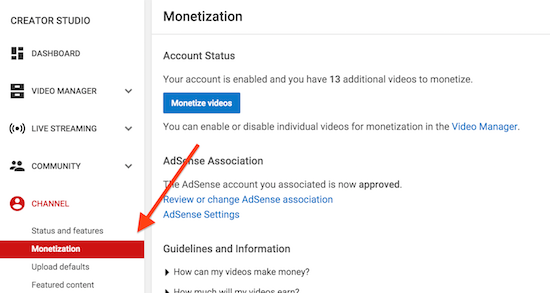
Once you have linked an AdSense account, you will have to option to enable monetization for each video on your channel. You can choose not to monetize some videos if you want to. If you click on Edit video, you will see an option to switch on monetization.
YouTube gives you flexibility to choose the type of ads that you want to run on your video.

You will also have the option of choosing when to show the ads on your video. (Sometimes new accounts do not have all the options).
Once monetization is enabled, ads will start serving on your videos.
Where is the Ad Revenue Credited?
You need an AdSense account if you are earning ad revenue from YouTube. Your earnings will be categorized into “Hosted AdSense for Content”.
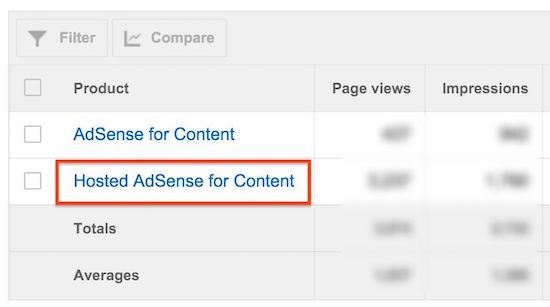
Usually adsense pays 68% share of the advertising revenue to publishers but with hosted content on Google’s property such as YouTube, the revenue share is 45/55. Publishers earn 55% of the advertising revenue. (Rough estimate, YouTube has not revealed the numbers.)
55% is OK because hosting a video on YouTube and getting traffic to it is much easier than getting traffic to your own websites.
Also the earnings from YouTube is not updated in real time. It is updated periodically. Real time earnings will be available for you inside YouTube analytics.

On the 15th of the month, your earnings will be added to your AdSense balance.
Next Action Steps
Now that you have learned everything about earning revenue with YouTube, now it is time to start taking some action. Here’s what you can do:
- Create a YouTube channel
- Create & Upload your first unique video (don’t infringe copyrights!)
- Create an AdSense account if you don’t have one already
- Enable monetization for your video
- Get your first 1,000 views to your video
- Earn your first dollar with YouTube
Very simple steps such as uploading videos to YouTube, creating a YouTube account etc. have been skipped for obvious reasons 🙂
Look forward to the future articles in this series.
Are you ready to earn $1,000 a month with YouTube? Leave a comment below and make a public commitment! Join me on my journey!